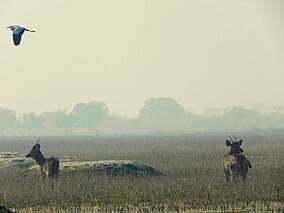Keoladeo National Park
The Keoladeo National Park[3] is an Indian bird sanctuary in Bharatpur, Rajasthan. It is also a declared World Heritage Site.[4]
| Keoladeo Ghana National Park | |
|---|---|
IUCN category II (national park) | |
 Keoladeo Ghana National Park, Bharatpur, Rajasthan, India | |
| Location | Bharatpur, Rajasthan, India |
| Nearest city | Bharatpur, Rajasthan |
| Coordinates | 27°10′00″N 77°31′00″E / 27.166667°N 77.516667°E |
| Area | 2,873 hectares (7,100 acres; 11.1 sq mi; 28.7 km2) |
| Established | 10 March 1982 |
| Visitors | 100,000 (in 2008)[1] |
| Governing body | Rajasthan Tourism Development Corporation |
| Official name | Keoladeo National Park |
| Criteria | Natural: (x) |
| Reference | 340 |
| Inscription | 1985 (9th Session) |
| Designated | 1 October 1981 |
| Reference no. | 230[2] |
History
changeKeoladeo Ghana National Park is a man-made and man-managed wetland and one of the national parks of India.
The wetlands were created in the mid-18th century. It is named after a Keoladeo (Shiva) temple within its boundaries. The area is a natural low spot in the land. It was flooded by two rivers, the Gambhir and Banganga.
The area was a hunting ground for the maharajas of Bharatpur after 1850. The Viceroy of India hunted birds in this special park.
Keoladeo was established as a national park on 10 March 1982.
The area was designated as a bird sanctuary on 13 March 1976.
In 1985, the Park was declared a World Heritage Site.
Geography
changeKeoladeo (Bharatpur) National Park (27°10'N, 77°31'E) is in eastern Rajasthan. It is 2 kilometers (km) south-east of Bharatpur and 50 km west of Agra.[5]
The Park is spread over approx 29 square kilometer area. One third of the Keoladeo National Park habitat is wetland. The uplands have grasslands (savannas) of tall species of grass together with scattered trees and shrubs present in varying density.[5]
In an area characterized by sparse vegetation, the park is the only spot which has dense vegetation and trees. .[5]
Dykes divide the wetland into ten units. Each unit has a system of sluice gates to control its water level.[5]
Scientific research and facilities
changeThe Bombay Natural History Society has done considerable work in the area.
Between December 1992 and January 1995, a collaborative project between the Governments of India and Russia, International Crane Foundation and Wild Bird Society of Japan was set up to save the Siberian crane. The project focused on releasing captivity bred cranes into the wild, tracking migratory routes of common cranes, and building up the resident crane population in the park..[6]
Related pages
changeReferences
change- ↑ "NPS Annual Recreation Visits Report". National Park Service.
- ↑ "Keoladeo National Park". Ramsar Sites Information Service. Retrieved 25 April 2018.
- ↑ The park also known as Keoladeo Ghana National Park and formerly known as the Bharatpur Bird Sanctuary.
- ↑ World Heritage Site, UNESCO World Heritage Status.
- ↑ 5.0 5.1 5.2 5.3 Site Description, Ramsar Site no. 230.
- ↑ Research and Field study initiatives, Scientific research at Keoladeo.
Other websites
changeMedia related to Keoladeo National Park at Wikimedia Commons
- Keoladeo National Park official site Archived 2016-03-25 at the Wayback Machine
- Keoladeo National Park on board the Palace on Wheels Archived 2012-06-06 at the Wayback Machine
- Wildlife in India | Keoladeo National Park
- WCMC Archived 2002-10-09 at the Library of Congress Web Archives
- Reuters: Drought-ridden Indian bird park loses its birds Archived 2007-12-23 at the Wayback Machine. Version of 2007-Feb-25. Retrieved 2007-Feb-27.
- List of birds
- Information on birds and region
